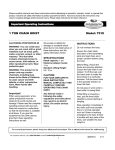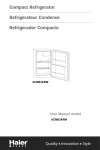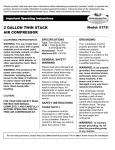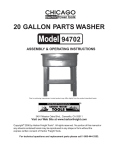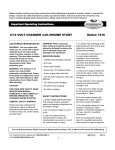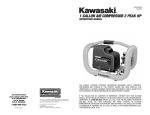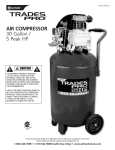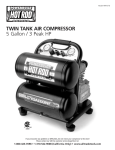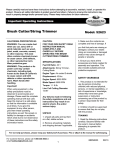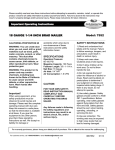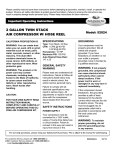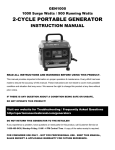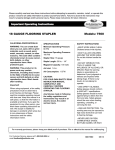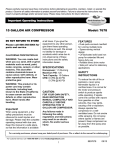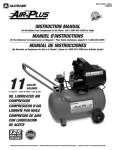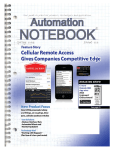Download SPEEDWAY 52401 Use and Care Manual
Transcript
Model: 52401, 52619, 52458, 52704 OIL FREE AIR COMPRESSOR CALIFORNIA PROPOSITION 65 WARNING: You can create dust when you cut, sand, drill or grind materials such as wood, paint, metal, concrete, cement, or other masonry. This dust often contains chemicals known to cause cancer, birth defects, or other reproductive harm. Wear protective gear. WARNING: This product or its power cord may contain chemicals, including lead, known to the State of California to cause cancer and birth defects or other reproductive harm. Wash hands after handling. Important! When using equipment, a few safety precautions must be observed to avoid injuries and damage. Please read the complete operating manual with due care. Keep this manual in a safe place, so that the information is available at all times. If you give the equipment to any other person, give them these operating instructions as well. We accept no liability for damage or accidents which arise due to nonobservance of these instructions and the safety information herein. SPECIFICATIONS Horsepower: 2 HP CFM @ 40 PSI: 5.1CFM CFM @ 90 PSI: 4.1 CFM Voltage: Single Phase; 120V,60 Hz Motor: 3500 RPM Tank: 20, 28 gallons* Oil Free Direct Drive Pump Max. Pressure: 130 PSI Maximum Duty Cycle: 75% CAUTION: FOR YOUR OWN SAFETY, READ INSTRUCTION MANUAL COMPLETELY AND CAREFULLY BEFORE OPERATING THIS COMPRESSOR. Any failures made in following the safety regulations and instructions may result in an electric shock, fire, and/or serious injury. DUTY CYCLE This air compressor pump is capable of running continuously. However, in order to prolong the life of your air compressor, it is recommended that a 50% average duty cycle be maintained. Duty cycle refers to the percentage of time a compressor can safely run within a given amount of time expressed as a ratio. Example: Oil lubricated compressors are typically rate at a 50% duty cycle, meaning that the compressor motor can run about 50% of the total time it is being used to supply air to a tool. During the ON time, the motor is running to pressurize the tank. During the OFF time, the motor is stopped and the tools are running off on the pressurized air stored in the tank. If your air tools are draining pressure off of the tank too quickly, the compressor motor must run more than 50% of the time the compressor is in use. This can lead to overheating and will significantly shorten the life of the compressors *Depending on model. For Customer Service, please call 1-800-348-5004 or email [email protected] 1 88052401 10/13 This compressor is designed for household use only and is not intended for commercial applications. It is well suited for doit-yourselfers with a variety of automotive and home uses. This instruction manual is intended for your benefit. Please read and follow the safety, maintenance, and troubleshooting steps described within to ensure your safety and satisfaction. The contents of this instruction manual are based upon the latest product information available at the time of publication. The manufacturer reserves the right to make product changes at any time without notice. WARNING: Read and understand this entire instruction manual before attempting to assemble, install, operate, or maintain this air compressor. Failure to comply with the instructions may result in serious personal injury and/or property damage. SAVE THESE INSTRUCTIONS FOR FUTURE REFERENCE. WARNING: Do not operate this air compressor if damaged during shipment, handling, or misuse. Damage may result in bursting, which can cause serious injury or property damage. All damaged parts must be repaired or replaced as needed prior to operating this air compressor. Check to see that all nuts, bolts, and fittings are secure before putting this air compressor into service. If you have any questions, or require assistance with damaged or missing parts, please contact our customer service center. READ ALL SAFETY WARNINGS BEFORE USING THIS AIR COMPRESSOR. [email protected] GENERAL SAFETY WARNINGS • Keep work area clean. Messy areas and cluttered workbenches invite personal injury and/or property damage. • Keep children and visitors away. All children should be kept away from the work area. DO NOT let children handle the compressor or extension cord. Maintain a safe distance for any person near the work area. • Operating any tools or equipment under the influence of drugs, alcohol, or medication can cause personal injury to yourself and others. • Wear proper apparel. Remove your jewelry before using air compressor. Do not wear loose clothing, necklaces, rings, bracelets, or other jewelry, which may get caught in moving parts. Nonskid footwear and electrically non-conductive gloves are highly suggested while working. Wear protective hair covering to contain long hair. • Protect your eyes. The operation of any air compressor can result in foreign objects being thrown into the eyes, which can result in severe eye damage. Always wear eye protection that meets ANSI Z28.1 specifications during air compressor operation. Eyeglasses are not always safety glasses. • Be responsible for your hearing. Wear hearing protection during extended periods of operation. • Use the right tool. Use tools properly and for their intended use. Do not force a small tool to do the job of a heavy-duty tool. Using the right tool to do the right job will make doing the job safer. • Check damaged parts before use of any air tools or attachments. A guard or other part that is damaged should be carefully checked to ensure that it 2 will operate properly and perform its intended function. Check for misalignment or binding of moving parts, breakage of parts, mounting, or any other conditions that may affect tool operation. A guard or other part that is damaged should be properly replaced. See replacement parts list for additional details. • Avoid unintentional starting. Be sure that your air compressor is in the OFF position before plugging it into a power cord or electrical receptacle. • Store all maintenance tools away from the immediate area before turning ON your air compressor. • Do not overreach. Proper footing and balance is a must at all times while using tools. Unstable support may lead to personal injury. Do not stand on the tool. Serious injury could result if the tool tips over or you accidentally contact the tool. • Never leave the air compressor running unattended. Always turn the power to the OFF position and do not leave the air compressor until it comes to a complete stop. • When using air accessories, consult the owner’s manual provided by the manufacturer. The use of improper accessories may cause risk of injury to yourself and others. • Always make sure the tool is in the OFF position and unplugged from the electrical receptacle when making adjustments, changing parts, or performing any maintenance. • Secure work. When possible, the use of clamps or a holding device is much safer than holding the work piece with your hands. • Keep protective guards in place • Operate the air compressor in a and in proper working condition. well-ventilated area. Do not direct paint or other spray material towards the compressor. Read and follow all safety instructions for the material you are spraying. • Maintain tools and equipment with care. they will function better and more safely when kept clean and in good working condition. Keeping the air compressor clean, dry, and free of grime will add to its life and performance. • Childproof the workshop. The use of master switches and padlocks is highly recommended. Remove starter keys where applicable. • Drain liquid from air tank daily • Use the drain valve located on the bottom of the lower air tank to drain. Failure to properly drain liquid from the tank will cause rust from moisture buildup, which weakens the tank and could lead to a violent tank explosion. Periodically inspect the tanks for unsafe conditions such as corrosion, cracked welds, and leaks. • Release air slowly when draining moisture or depressurizing the air compressor. Fast moving air will stir up dust, dirt, and debris, and may be harmful. • Risk of fire or explosion • Avoid dangerous environments. Do not spray combustible/flammable liquid in a confined area. Spray area must be well ventilated. Do not smoke while spraying or spray where spark or flame is present. Arcing parts keep compressor at least 20 ft. away from spraying area and all explosive vapors. Do not use compressor near gasoline or other flammable materials. [email protected] • Risk of injury • Do not direct air stream at body. Use eye protection. Compressor starts automatically. Do not touch moving parts. Keep guards in place. Compressor does not supply breathable air. • Risk of bursting • Do not adjust regulator to result in output pressure greater than marked maximum pressure of attachment. If a regulator has not been installed, use only attachment rated at 200 PSI or higher. Do not weld on or repair tank - A DAMAGED TANK MUST BE REPLACED IMMEDIATELY. Do not operate without proper safety valve in place. • Never attempt to repair or make modifications to the tank or its attachments. Welding, drilling, or any other modifications may weaken the tank, which may result in damage from rupture or explosion. Never remove or attempt to adjust the pressure switch, safety valve, or other components that control tank pressure. Never substitute parts or attempt to alter the factory set operating pressures. • Risk of burns • Touching exposed metal such as the compressor head or exhaust tube can result in serious burns. Keep 3 hands and fingers away from exposed metal parts on air compressor during or immediately after operation. Air compressors generate significant heat during normal operation and will remain hot for some time after use. Do not reach around protective shrouds or attempt any maintenance until compressor has been allowed to cool. • Risk of flying objects Do not direct compressed air stream at people or pets. The powerful compressed air stream can damage exposed skin and easily propel loose dirt and other small objects at high-speed, resulting in serious injury. Always wear eye protection that meets ANSI Z28.1 specifications. Use only OSHA approved air blowguns. Never leave a pressurized air compressor unattended. Shut OFF air compressor and relieve pressure before performing maintenance or repairs. Do not move the air compressor while the air tank is pressurized. Never attempt to move the air compressor by pulling on the air hose. • Risk of falling Portable air compressors can fall from a table, workbench, or roof causing damage to the compressor and could result in serious injury or death to the operator. Always operate air compressor in a stable and secure position to prevent accidental movement of the unit. Never operate air compressor on a roof or other elevated position. Use additional air hose to reach high locations. • Air tools and accessories Do not exceed the pressure rating of any air tool, spray gun, air accessories, or inflatables. Excess pressure can cause them to explode, resulting in serious injury. Follow the manufacturer’s recommended pressure settings for all air tools and air accessories. INSTALLATION & LOCATION Caution: In order to avoid damaging the air compressor, do not allow the unit to be tilted from the normal vertical position when operating. The compressor must be run with the rubber feet resting on a flat and stable horizontal surface. The air compressor must be used in a clean and well-ventilated area.The compressor requires an unobstructed airflow and must be located a minimum of 20 inches from any walls or other obstructions that may prevent proper ventilation. other combustible materials. When using the air compressor for spraying paint, place the air compressor as far away from the work as possible, using extra lengths of air hose to extend the working reach instead of extension cords. GROUNDING INSTRUCTIONS This product should be grounded. In the event of an electrical short circuit, grounding reduces the risk of electric shock by providing an escape wire for the electric current. This product is equipped with a cord having a grounding wire with an appropriate grounding plug. The plug must be plugged into an outlet that is properly installed and grounded in accordance with all local codes and ordinances. Caution: DO NOT place air compressor in an area: • Where there is evidence of oil or gas leaks. • Where flammable gas vapors or materials may be present This product is for use on a nominal 120-volt circuit and has a three-prong grounding plug that looks like the plug illustrated in Figure 1. A temporary adapter similar to the adapter illustrated in Figure 1-B may be used to connect this plug to a 2-pole receptacle as shown in figure 1-B when a properly grounded outlet is not available. The temporary adapter shall be used only until a properly grounded outlet (Figure 1-A) is installed by a qualified electrician. Tab for grounding screw, lug, or similar part extending from the adapter must be connected to a permanent ground such as a properly grounded outlet box cover. Whenever the adapter is used, it must be held in place by a metal screw. The use of a GFCI outlet is strongly recommended. The third prong is to be used to ground the tool and provide protection against electrical shock. Never remove the third prong. • Where are temperatures fall below 32°F or exceed 104°F. • Where extremely dirty air or water could be drawn into the air compressor. Check with a qualified electrician or serviceman if the grounding instructions are not completely understood, or if in doubt as to whether the product is properly grounded. Do not modify the plug provided. If it will not fit the outlet, have the proper outlet installed by a qualified electrician. WARNING: Serious injury or death may occur if electrical sparks from motor and pressure switch come in contact with flammable vapors, combustible dust, gases, or [email protected] DANGER: Improper installation of the grounding plug can result in a risk of electric shock. If repair or replacement of the cord is necessary, do not connect the grounding wire to either flat blade terminal. The wire with GREEN insulation with or without yellow stripes is the grounding wire. 4 EXTENSION CORDS CAUTION: The use of an extension cord with this product is not recommended as this can result in the loss of power to your air compressor which can prevent the motor from starting or running properly. This can also cause your fuse to blow or circuit breaker to trip.. Running your air compressor on an undersized extension cord will cause permanent damage to internal switches and overheating of the electric motor. Use an additional length of air hose rather than an extension cord. If you must use an extension cord , it should be plugged into a GFCI found in circuit boxes or protected receptacles. Use only UL listed 3wire extension cords that have a 3-blade grounding plug and a 3slot receptacle that will accept the plug on the product. Make sure your extension cord is in good condition. When using an extension cord, be sure to use one heavy enough to carry the current your product will draw. Refer to the guide for minimum gauge required for extension cords. receptacle; always disconnect by pulling on plug. Keep cord away from heat and sharp edges. Always shut OFF the air compressor AUTO/ON pressure switch before unplugging the compressor. Always disconnect the extension cord from the receptacle before disconnecting the product from the extension cord. WARNING: Avoid electrical shock hazard. Never use this compressor with a damaged or frayed electrical cord or extension cord. Inspect all electrical cords regularly. Never use in or near water or in any environment where electric shock is possible. To reduce the risk of electrocution, keep all connections dry and off the ground. Do not touch the plug with wet hands. Guard against electrical shock. Avoid body contact with grounded services such as pipes, ovens, stoves, and refrigerator enclosures. If not properly grounded, this air compressor can incur the potential hazard of light trickle shock, particularly when used in damp locations. If electrical shock occurs, there is the potential of secondary hazard such your hands contacting an operating air tool. COMPRESSOR FEATURES: Use only extension cords that are intended for outdoor use. These cords are identified by a marking “ACCEPTIBLE FOR OUTDOOR APPLIANCES, STORE INDOORS WHEN NOT IN USE.” Examine extension cord before use. DO NOT USE DAMAGED EXTENSION CORDS. Do not pull on cord to disconnect from [email protected] 1. AUTOMATIC ON/OFF PRESSURE SWITCH: This compressor is equipped with an automatic ON/OFF pressure switch. The compressor will only run when the switch is in ON/AUTO position. Once the tank has reached the desired preset pressure (“cut-out” pressure), the pump motor will automatically shut off. While the switch is in the ON/AUTO position, the pump motor will automatically turn back on once the pressure in 5 the tank drops below the minimum preset pressure (“cut-in” pressure). WARNING: Do not leave the compressor unattended while the power switch is in the ON/AUTO position. 2. AIR TANK PRESSURE GAUGE: The tank pressure gauge provides a reading of the air pressure inside of the compressor tank. 3. OUTLET PRESSURE GAUGE: The outlet pressure gauge provides a reading of the air pressure at the outlet side of the regulator. This pressure is controlled by the pressure regulator and is always less than or equal to the air tank pressure. 4. DUAL AIR COUPLERS: The air couplers are preinstalled into standard 1/4” NPT (F) threads in the pressure manifold. Use PTFE thread-sealing tape on the threads to make sure you have an airtight connection when replacing quick connect couplers. 5. PRESSURE REGULATOR: The regulator allows you to select the amount of air pressure that is output through the air hose into tools and accessories. Turn the pressure regulator knob clockwise to increase discharge pressure, and counter clockwise to decrease discharge pressure. Please refer to the air delivery requirements of your tools for the proper pressure settings. NOTICE: Be careful not to over tighten pressure regulator knob when it “bottoms out” as this may damage pressure regulator. 6. SAFETY RELIEF VALVE: This compressor is equipped with a safety relief valve that is designed to prevent system failures by relieving pressure from the system when the air pressure reaches a predetermined level. The safety relief valve is preset by the manufacturer. DO NOT attempt to modify or remove the safety relief valve. 7. AIR TANK DRAIN VALVE: Moisture is produced whenever air is compressed. It is critical to drain water from the air tank on this compressor frequently. If unit is used only occasionally, tank should be drained after each use and prior to the next use. To drain the tank, slowly open the tank drain fitting by turning counterclockwise Once all moisture has drained out, close the fitting securely. NOTE: Air tank will not pressurize while drain valve is open. NOTE: A dirty air filter will reduce air compressor performance and can lead to product failure. 8. MANUAL THERMAL OVERLOAD SWITCH: The electric motor has a manual thermal overload protector. If the motor overheats for any reason, the thermal overload protector will shut off the motor. Turn pressure switch to the OFF position and wait for unit to cool before pushing the reset button and restarting the compressor. NOTICE: This air compressor is designed for household use only and is not intended to operate heavy-duty air tools. If your application’s demands exceed the capacity of this air compressor, a larger air compressor that is matched to your application is recommended. If the unit shuts down again, please call the customer service center for additional assistance. 9. AIR INTAKE FILTER: This compressor is equipped with an [email protected] externally accessible air intake filter that is designed to clean air coming into the pump. The filter element is easily removed for periodic cleaning. Use compressed air to blow loose dirt and debris from the paper filter element and reinstall. Replace filter element when necessary. 10. HANDLE: Convenient handle for easy transport. OPERATING THE AIR COMPRESSOR INITIAL SET-UP/BREAK-IN PROCEDURE: Caution: Do not attach air hose, air tools, or other accessories to the air outlet until break-in procedure has been successfully completed. 1. Read and understand the entire instruction manual, including all safety warnings before setting up air compressor. 2. Place air compressor on a flat, level surface. 3. Turn the pressure regulator knobs fully clockwise to open airflow from air outlet port. NOTE: Be careful not to over tighten pressure regulator knob when it “bottoms out” as this may damage pressure regulator. 4. Turn the power switch to the OFF position. 5. Plug the power cord directly into a properly grounded power source of the correct voltage (see Grounding instructions). 6. Open the tank drain valve to allow air to escape preventing air pressure buildup in the air tank. 6 7. Turn the compressor ON by moving the switch to the AUTO/ON position and run the air compressor for a period of 20 minutes to break-in the air pump. 8. With the compressor still running, at the end of the 20minute break-in period, close the tank drain valve. The air compressor will build air pressure to the maximum preset pressure (“cut-out” pressure) and automatically shut-off. 9. Slowly turn the tank drain valve to open airflow from drain and bleed off air from the air tank. The air compressor will automatically restart once the pressure in the air tank drops below the minimum preset pressure (“cut-in” pressure). 10. Turn the compressor off by moving the switch to the OFF position. 11. Release the pressure from the system. Drain moisture from the air tank by slowly opening the air tank drain valve by turning counterclockwise. Tilt tank to remove all moisture. Once all the moisture has drained out, close the fitting securely. NOTE: Air tank will not pressurize while drain valve is open. 12. Disconnect the power cord from the power outlet. NOTE: Make sure the power switch is in the OFF position when connecting or disconnecting power cord from electrical outlet. 13. Your new air compressor is now ready to use. STARTUP 1. Before each startup, make sure the power switch is in the OFF position. 2. Place the air compressor on a flat, level surface. 3. Release pressure from the system. Drain moisture from the air tank by slowly opening the air tank drain valve by turning counterclockwise. Once all the moisture has drained out, close the fitting securely. NOTE: Air tank will not pressurize while the drain valve is open. 4. Turn the pressure regulator knob fully counterclockwise to close airflow from air outlet port. 5. Attach air hose and accessories. WARNING: Too much air pressure causes a hazardous risk of bursting. Check the manufacturer’s maximum pressure rating for air tools and accessories. The regulator outlet pressure must never exceed the maximum pressure rating. 6. Before connecting the compressor to the grounded outlet, check for broken components and accessories, and check for damage to the hose. 7. Plug power cord direcly into a properly grounded power source of the correct voltage (see grounding instructions). 8. Turn the compressor ON by moving the switch to the AUTO/ON position and allow tank pressure to build. Once the air pressure reaches the maximum [email protected] preset pressure (“cut-out” pressure) it will automatically shut off. 6. Allow the compressor to cool down. 9. Slowly turn the pressure regulator knob clockwise to open airflow from air outlet port until desired output pressure is reached. 7. Wipe the air compressor clean and store it in a clean, dry, and non-freezing location. NOTE: The air compressor will automatically restart once the pressure in the air tank drops below the minimum preset pressure (“cutin” pressure). WHEN PERFORMING ANY MAINTENANCE OR SERVICE: 1. The air compressor must be turned off. MAINTENANCE & CLEANING 2. Disconnect compressor from the power source. WARNING: Disconnect air compressor from the power source and bleed off all air pressure before attempting any maintenance or repair. 3. Open tank drain to bleed off all air pressure before attempting any maintenance or repair. SHUTDOWN & STORAGE NOTE: NEVER stop the air compressor by unplugging it from the power outlet as this may result in damage to the compressor. 1. Turn the switch to the OFF position. 2. Disconnect the power cord from the power outlet. Disconnect the power cord from the power outlet by grabbing the plug (not the cord). Loop around electric cord holder for storage. 3. Turn the pressure regulator knob fully counterclockwise to close airflow from air outlet port. Check the outlet pressure gauge to ensure that it reads 0 PSI. 4. Remove the air hose and any air accessories. 5. Drain moisture from the air tank by slowly opening the air tank drain valve by turning counterclockwise. Tilt tank to remove all moisture. Once all the moisture has drained out, close the fitting securely. 7 4. Allow compressor to fully cool before attempting any maintenance or repair. Check the air compressor frequently for any visible problems and follow maintenance procedures each time the compressor is used. MAINTENANCE CHECKLIST Daily: o Drain accumulated liquid from tank o Check for unusual noise and/or vibrations o Check that all fasteners are secure o Wipe compressor clean Weekly: o Inspect and clean air filter Monthly: o Check for air leaks o Check safety relief valve CHECKING SAFETY RELIEF VALVE WARNING: Safety relief valve must be replaced if it cannot be actuated or it leaks air after the ring is released. 1. The air compressor must be turned OFF. 2. Disconnect compressor from the power source. 3. Open tank drain to bleed off all air pressure before attempting any maintenance or repair. 4. Allow compressor to fully cool before attempting any maintenance or repair. 5. Grasp the wire ring on the safety relief valve. 5. Remove the face of the filter body to access the filter element by removing screw holding filter in place. 6. Use compressed air to blow loose dirt and debris from the paper filter element. Replace filter element if it cannot be cleaned sufficiently. 7. Reinsert filter element into filter body and reinstall filter faceplate. MOISTURE IN COMPRESSED AIR Moisture is a normal by-product of compressing air. As the moisture builds during compressor use, it can be carried through the air hose. When using paint spray gun or sandblasting gun, the use of a special filter to remove moisture from the air line is highly recommended. Moisture in the compressed air will cause water spots in paint jobs and cause blasting media to clog the sandblasting gun. 6. Pull and release the ring a few times to ensure that the plunger moves in and out. Replace the safety relief valve if plunger does not move or is difficult to move. CHECKING AIR FILTER ELEMENT 1. The air compressor must be turned OFF. 2. Disconnect compressor from the power source. 3. Open tank drain to bleed off all air pressure before attempting any maintenance or repair. 4. Allow compressor to fully cool before attempting any maintenance or repair. [email protected] 8 Symptom Possible Cause(s) Corrective Action Power cord not plugged in Plug cord into grounded outlet Motor/Pressure switch in OFF position Move switch to AUTO position Motor thermal overload switch has tripped Turn air compressor off, wait until the motor is cool, then press motor thermal overload (red) button firmly until click is heard. Replace fuse or reset circuit breaker Check for proper fuse amperage Fuse blown or circuit breaker has tripped Check for low voltage conditions Wrong gauge wire or length of extension cord Check chart in instruction manual for proper gauge wire and cord length. Air tank pressure exceeds motor/pressure switch “cut-in” pressure Motor will start automatically when air tank pressure drops below “cut-in” pressure of motor/pressure switch Pressure release valve on motor/pressure switch has not unloaded pump head pressure Bleed the line by moving the switch to the OFF position Defective motor, motor capacitor, motor/pressure switch Contact customer service Motor/pressure switch does not shut off motor when air compressor reaches “cut-out” pressure and safety relief valve activates Move the motor/pressure switch to the OFF position. If the motor does not shut off, unplug the air compressor. If the electrical contacts are welded together, replace the pressure switch. Air Leaks Check all hose & coupler fittings for leaks with soapy water. Detach leaky fittings and apply new Teflon tape. If air hose is punctured, replace. Air compressor is incorrectly sized Limit the air pressure to the capacity of the air compressor. Either use a smaller tool or a larger air compressor. Defective pilot valve, the check valve is stuck open Remove, clean, or replace The compressor does not start or restart When in the start/stop option, motor runs continuously Air continues to leak at motor/pressure switch release valve after motor stops [email protected] 9 Disconnect any other electrical appliances from circuit or operate air compressor on its own branch Symptom Possible Cause(s) Corrective Action Defective motor/pressure switch Replace Check valve stuck in open position Replace check valve DANGER - Do not disassemble the check valve with tank pressurized. Open tank petcock valve to allow air to escape from tank prior to servicing. Possible defective safety relief valve Operate safety relief valve manually by pulling on ring. If it still leaks, it should be replaced. Excessive tank pressure Defective motor/pressure switch. Replace. Air leaks at fittings Fittings are not tight enough Tighten fittings where air can be heard escaping. Check fittings with soapy water solution. DO NOT OVERTIGHTEN. Air leaks in air tank Defective or rusted air tank Air tank must be replaced. DO NOT ATTEMPT TO REPAIR AIR TANK! Air blowing from inlet filter Damaged inlet (reed) valve Contact customer service Pressure regulator knob is not turned to high enough pressure Adjust pressure regulator knob to proper setting Defective motor/pressure regulator switch Replace Restricted air intake filter Clean or replace the filter element Air leaks Check for leaks by applying soap solution to all fittings and connections. Bubbles will appear at leakage points. Tighten or replace leaking fittings or connections as needed. Hose or hose connections are too small or long Replace with larger hose or connectors Air compressor is not large enough for air requirement Check the accessory air requirement. If it is higher than the CFM or pressure supply of the air compressor, you need a larger air compressor. Condensation in air tank caused by high level of atmospheric humidity or air compressor is not running long enough Drain tank after every use. Drain air tank more often in humid weather and use an air line filter/ Air continues to leak at motor/pressure switch release valve while motor is running Air leaks from safety relief valve Insufficient pressure at air tool or air accessory Moisture in discharge air [email protected] 10 North American Tool Industries (NATI) makes every effort to ensure that this product meets high quality and durability standards. NATI warrants to the original retail consumer a 1-year limited warranty from the date the product was purchased at retail and each product is free from defects in materials. Warranty does not apply to defects due directly or indirectly to misuse, abuse, negligence, or accidents, repairs or alterations, or a lack of maintenance. NATI shall in no event be liable for death, injuries to persons or property, or for incidental, special, or consequential damages arising from the use of our products. To receive service under warranty, the original manufacturer part must be returned for examination by an authorized service center. Shipping and handling charges may apply. If a defect is found, NATI will either repair or replace the product at its discretion. DO NOT RETURN TO STORE For Customer Service: Email: [email protected] or Call 1-800-348-5004 [email protected] 11 OIL FREE AIR COMPRESSOR Model: 52401, 52619, 52458, 52704 For Customer Service, please call 1-800-348-5004 or email [email protected] 12 88052401 10/13 OIL FREE AIR COMPRESSOR Model: 52401, 52619, 52458, 52704 For Customer Service, please call 1-800-348-5004 or email [email protected] 13 88052401 10/13 OIL FREE AIR COMPRESSOR Model: 52401, 52619, 52458, 52704 # 1 2 3 4 5 6 7 8 9 10 11 12 13 14 15 16 17 18 19 20 21 22 23 24 25 26 27 28 29 30 31 32 33 34 35 36 37 Description Release Pip Power Cord Pressure Switch Pressure Gauge Nut Ring Quick Coupler Regulator Plug Safety Valve Check Valve Feet Pad Washer Bolt, M5 Drain Valve Nut Washer Wheel Axle Cover Tank Bolt Handle Grip Handle Pump Bolt Connector Discharge Pipe Elbow Plastic Cover Bolt Plastic Pad Shroud, Front Circuit Breaker Bolt Spring Washer Washer QTY. 1 1 1 2 3 1 2 1 1 1 1 2 2 2 1 2 2 2 2 2 1 4 1 1 1 4 1 1 1 1 1 1 1 1 1 1 1 # 38 39 40 41 42 43 44 45 46 47 48 49 50 51 52 53 54 55 56 57 58 59 60 61 62 63 64 65 66 67 68 69 70 71 72 73 For Customer Service: Call 1-800-348-5004 or Email [email protected] 14 Description Fan Bearing Connect-Rod Spring Wasehr Bolt, M5 Crank Shaft Crankcase Cylinder Nut Dentiform Washer Stator Capacitor Bolt, M4 Dentiform Washer Bearing Rotor End Cover Spring Washer Bolt, M6 Cylinder Gasket Valve Plate Reed Valve Filter Plasatic Plate Valve Gasket Bolt, M6 Spring Washer Washer Cylinder Head Cylinder Head Gasket Shroud, Rear Bolt, M6 Piston Cover Piston Ring Guide Ring Bolt QTY. 1 1 1 1 1 1 1 1 2 2 1 2 2 2 2 1 1 4 4 1 1 2 1 1 1 4 4 4 1 1 1 1 1 1 1 1

















